Are you aware of the critical role recycling batteries plays in conserving resources and protecting the environment? With the rapid increase in demand for lithium-ion batteries in electric vehicles and electronic devices, the need for efficient and sustainable recycling batteries practices has never been more pressing.
This comprehensive guide will provide you with valuable insights into the various types of batteries, recycling processes, and the future of recycling batteries.
Key Takeaways
- This guide provides an understanding of different battery types and their importance in recycling for resource conservation.
- Lithium-ion batteries are a preferred choice due to safety, lifespan, rapid charging and broader operating temperature range. Rechargeable batteries offer sustainable cost efficiency while single use should be recycled responsibly.
- Federal & State laws exist to promote responsible disposal & recycling practices with hydrometallurgical processes being the most efficient option for lithium extraction.
Table of Contents
Understanding Different Battery Types
Battery Recycling Laws and Regulations
How to Properly Dispose of and Recycle Batteries
Single-Use Batteries
Rechargeable Batteries
Automotive Batteries
Sustainable Practices in Battery Recycling
Hydrometallurgical Processes
Selective Lithium Recovery
Battery Recycling Services and Facilities
Identifying and Handling Batteries for Recycling
The Future of Battery Recycling
Summary
Frequently Asked Questions
Understanding Different Battery Types

Batteries come in various shapes, sizes, and chemistries to suit a plethora of applications, ranging from powering electronic devices to electric vehicles. Knowledge of various types of batteries, including:
- lithium-ion
- lithium-ion phosphate
- rechargeable
- single-use
- lead-acid
aids proper recycling and disposal. With a rapid increase in demand for lithium-ion batteries in recent times, the need to manage battery waste and recover critical minerals like cobalt, lithium, and graphite for future generations has become increasingly important.
Recognizing the potential risks associated with battery waste, governments worldwide have implemented battery recycling laws and regulations to ensure safe disposal and recycling practices.
This guide will help you comprehend the complexities of different battery types and their importance in the recycling process, ensuring the conservation of valuable resources while minimizing environmental impact.
Lithium-Ion Batteries
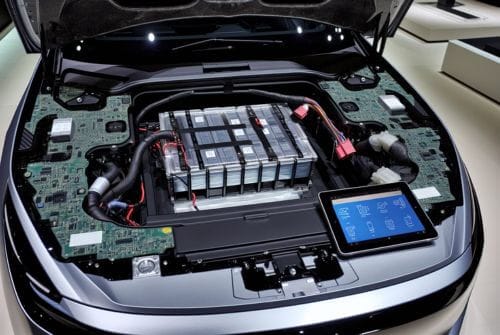
Li ion batteries, also known as lithium-ion batteries, have become the go-to choice for electric vehicles and electronic devices due to their high energy density and long life cycle. These rechargeable batteries are composed of:
- A cathode
- An anode
- A separator
- An electrolyte
These components work together to provide a reliable and efficient power source.
Lithium -Ion Phosphate Batteries
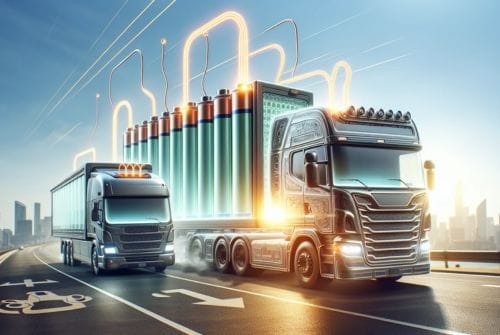
Lithium iron phosphate (LiFePO4) batteries, a subtype of lithium-ion batteries, are known for their remarkable longevity, high power density, and safety features. Given their significant benefits, recognizing the appropriate handling and recycling methods for lithium-ion batteries helps in their efficient and responsible disposal.
Lithium-ion phosphate batteries are popular in large-sized applications, such as buses and large vehicles, due to their electrode stability and heat tolerance. These batteries offer an extended lifespan, enhanced safety, rapid charging, and a broader operating temperature range, making them a preferred choice for energy storage systems and electric vehicles.
The electrode stability of LiFePO4 batteries offers many benefits for large-scale applications, including:
- High energy expressions
- Less use of passive components
- Higher energy storage capacity ratio
- Improved cyclic stability and specific capacity of cathode materials
As a result, these batteries play a significant role in the transition towards cleaner and more sustainable energy solutions.
"Lithium Iron Phosphate (LiFePo4) batteries are becoming increasingly favored for small-scale home applications, offering remarkable efficiency, extended lifespan, and lightweight design. They are particularly well-suited for off-grid residential solar setups, camping adventures, boating excursions, and more. Discover our comprehensive review of 100Ah LiFePo4 batteries tailored for home utility."
Rechargeable Batteries

Rechargeable batteries can be employed multiple times, offering a more environmentally friendly and cost-effective alternative to single-use batteries. They can be utilized in a wide range of applications. These batteries come in various types, including:
Lead-acid
Nickel-cadmium (NiCd)
Nickel-metal hydride (NiMH)
Lithium-ion batteries
Recycling rechargeable batteries not only helps reduce waste but also conserves valuable resources by recovering raw materials like:
nickel
cadmium
lithium
cobalt
manganese
Choosing rechargeable batteries and recycling them responsibly aids in creating a more sustainable future, ensuring the availability of these valuable materials for future generations.
Single-Use Batteries
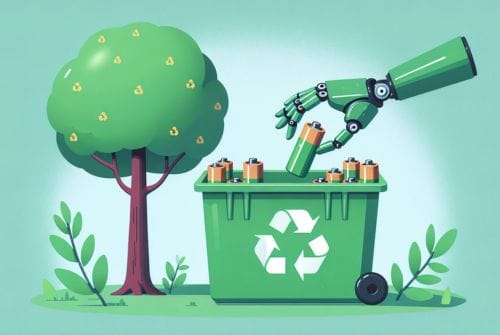
Single-use batteries can be the small batteries found in a range of everyday devices, including:
Remote controls
Computer mice
Wall clocks
Digital scales
Toys
These coin batteries contain a variety of battery components, such as metals and chemicals, which can be repurposed to generate electrical energy from spent batteries, thus promoting resource conservation.
Recycling single-use batteries is essential to:
- Ensure the appropriate handling of toxic materials
- Reduce the need for new lithium extraction, which can have negative environmental impacts
- Aid in environmental protection and resource conservation for future use
You can recycle single-use batteries at designated locations or through mail-in programs like the Big Green Box.
Lead-Acid Batteries
Lead-acid batteries are commonly used in vehicles, marine applications, and backup power systems. These batteries contain hazardous materials, such as sulfuric acid and lead, which can pose risks to human health and the environment if not handled and disposed of properly.
Safety is paramount when recycling lead-acid batteries. They should be returned to a battery retailer or local hazardous waste collection program. By following the appropriate recycling procedures for lead-acid batteries, we can help minimize the environmental impact and protect our health and well-being.
Battery Recycling Laws and Regulations
Battery recycling laws and regulations vary at the federal and state levels, ensuring proper disposal and recycling practices for different types of batteries.
The Battery Act of 1996, for example, aimed at phasing out the use of mercury-containing batteries and facilitating the recycling of nickel-cadmium and small sealed lead-acid batteries.
However, state laws might vary, thus checking local regulations for battery recycling requirements becomes necessary.
Adhering to these laws and regulations aids in fostering a cleaner and more sustainable future for all.
Federal Laws
The Battery Act of 1996 is a crucial federal law that enhanced the recycling process and promoted sustainable practices in the battery industry. Although there are no explicit U.S. federal laws devoted to battery recycling, the Environmental Protection Agency (EPA) advises businesses to manage lithium-ion batteries under the Resource Conservation and Recovery Act’s (RCRA) “universal waste” regulations.
Following these regulations helps businesses ensure responsible battery handling and disposal while reducing their environmental impact.
State Laws
State laws may differ in their approach to battery recycling, so it is essential to check local regulations for specific requirements. Some states, like New York, Florida, and Michigan, have particular regulations and requirements for battery recycling.
Compliance with these state laws by individuals and businesses supports responsible battery disposal and recycling practices, thereby ensuring environmental protection and human health.
How to Properly Dispose of and Recycle Batteries
Proper disposal and recycling of single-use, rechargeable, and automotive batteries are essential for safeguarding the environment and preserving resources.
Different types of batteries require specific recycling methods, and it is crucial to follow the appropriate procedures in order to ensure the safe and effective recycling of these batteries.
In the following subsections, we will discuss the proper disposal and recycling methods for each type of battery.
Single-Use Batteries
Single-use batteries should be recycled at specific locations or through mail-in programs like the Big Green Box (or WeRecycle Battery Box). These batteries contain various chemicals and heavy metals that can be hazardous if not managed and disposed of correctly.
Recycling single-use batteries at designated locations aids in proper handling of toxic materials and contributes to a cleaner, more sustainable future.
Rechargeable Batteries
Rechargeable batteries should be handled with care and recycled at designated locations. These batteries can be charged and used multiple times, making them a more environmentally friendly and cost-effective alternative to single-use batteries.
Responsible recycling of rechargeable batteries aids in waste reduction and resource conservation, especially when it comes to waste batteries.
Automotive Batteries
Automotive batteries should be returned to battery retailers or local hazardous waste collection programs for recycling. These batteries contain hazardous materials, such as sulfuric acid and lead, which can pose risks to human health and the environment if not handled and disposed of properly.
Following the appropriate recycling procedures for automotive batteries minimizes the environmental impact and safeguards our health and well-being.
Sustainable Practices in Battery Recycling
Sustainable practices in battery recycling, such as hydrometallurgical processes and selective lithium recovery, play a vital role in reducing the environmental impact and promoting circular economy principles.
Adopting these sustainable practices ensures resource conservation and a recycling process that’s efficient and environmentally responsible.
Hydrometallurgical Processes
Review of one company's process.
Hydrometallurgical processes are more environmentally friendly and efficient for recycling lithium-ion phosphate batteries. These processes involve the use of aqueous solutions to extract metals from ores, allowing for a more sustainable approach to lithium ion battery part recycling.
Employing hydrometallurgical processes in the recycling of lithium-ion phosphate batteries aids in reducing the environmental impact and promotes more sustainable practices in the battery industry.
Selective Lithium Recovery
Selective lithium recovery methods help conserve resources and reduce waste in the recycling process. These methods involve selectively extracting lithium from spent lithium-ion batteries, preventing resource depletion and environmental pollution.
Efficiently recovering lithium from discarded batteries has several benefits:
- It conserves valuable lithium resources
- It allows for the reuse of lithium in the manufacturing of new batteries
- It reduces the need for new lithium extraction
- It reduces the associated environmental impacts
Battery Recycling Services and Facilities
Battery recycling services and facilities, including nationwide services and EPA-compliant facilities, play a crucial role in ensuring the proper handling and disposal of batteries. These services and facilities adhere to strict regulations and guidelines, providing a safe and sustainable solution for battery recycling.
In the following subsections, we will discuss the different types of recycling services and facilities available and their role in promoting responsible battery disposal.
Nationwide Services
Nationwide services like Battery Recyclers of America provide battery pickup and recycling services across the United States. They offer:
- Safe disposal of batteries
- Compliance with all regulatory requirements
- Next-day pickup services
- White-glove service options when necessary
Utilizing these nationwide services allows individuals and businesses to contribute to a cleaner, more sustainable future for all.
EPA-Compliant Facilities
EPA-compliant facilities adhere to strict regulations for battery recycling, ensuring safe and sustainable practices. These facilities follow the guidelines and regulations established by the Environmental Protection Agency (EPA) for the correct handling and disposal of batteries, guaranteeing environmental protection and safety.
Choosing to recycle batteries at EPA-compliant facilities helps minimize the impact of battery waste on our environment and ensures a sustainable future.
Identifying and Handling Batteries for Recycling
Identifying and handling batteries for recycling, such batteries such as lithium iron phosphate and button cell batteries, is crucial for safe and effective recycling.
Different types of batteries require specific handling and recycling methods, and it is important to recognize these distinctions in order to ensure the proper disposal and recycling of batteries.
In the following subsections, we will discuss the identification and handling of various battery pack types for recycling.
Lithium Iron Phosphate Batteries


Lithium Ion Batteries-left for watches, right for laptop
Lithium iron phosphate batteries require specialized techniques for recycling and should be properly identified before disposal. These batteries are commonly used in large-scale applications, such as buses and large vehicles, and their recycling process involves shredding and sorting their components, including metals, plastics, and secondary materials.
Recognizing the special requirements of lithium iron phosphate batteries ensures their efficient and responsible recycling.
Button Cell Batteries


Examples of button cell batteries
Button cell batteries should be stored out of reach of children and recycled through specialized recyclers or household hazardous waste collection programs.
These small, round batteries are commonly used to power a variety of electronic devices, mostly small electronics including watches, clocks, and calculators, and contain various chemicals and heavy metals that can be hazardous if not managed and disposed of correctly.
Properly handling and recycling button cell batteries helps protect the environment and conserve valuable resources.
The Future of Battery Recycling
The future of battery recycling involves addressing research directions and challenges, as well as exploring new opportunities for sustainable practices. As the demand for critical materials and minerals used in battery production continues to grow, the need for efficient and environmentally friendly recycling methods becomes increasingly important.
In the following subsections, we will discuss the research directions and challenges in battery recycling, as well as the potential opportunities for the future.
Research Directions
Research should focus on developing large-scale and commercialized regeneration techniques for lithium-ion batteries. This includes investigating:
- Novel strategies that permit more efficient dissolution of metals and separation from battery waste
- Innovative designs to enhance the lifetime value of batteries
- The fabrication of direct recycling techniques
Advancing research in battery recycling ensures a more sustainable future and the continued availability of critical minerals for future generations.
Challenges and Opportunities
Challenges in battery recycling include proper disposal, retaining storage capacity for second use, and the need for separate recycling departments. However, these challenges also present new opportunities for sustainable practices and the development of innovative recycling methods.
Addressing these challenges and embracing the opportunities they present aids in creating a more sustainable future for battery recycling and the conservation of valuable resources.
Summary
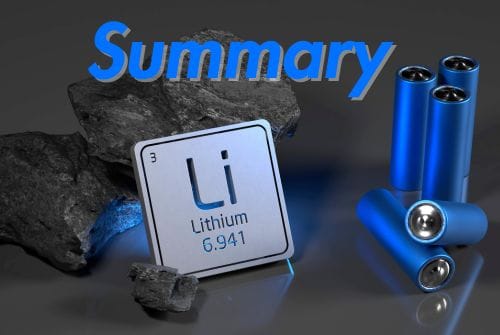
In conclusion, battery recycling is an essential process that plays a critical role in conserving resources and protecting the environment. By understanding the different types of batteries, recycling laws and regulations, and sustainable practices, we can ensure the proper disposal and recycling of batteries, thus promoting a cleaner and greener future for all.
As we continue to rely on batteries for powering our electronic devices and electric vehicles, it is our responsibility to recycle them responsibly and contribute to a more sustainable future. So, the next time you replace a battery, remember to recycle it properly and do your part in preserving our environment and valuable resources.
Frequently Asked Questions
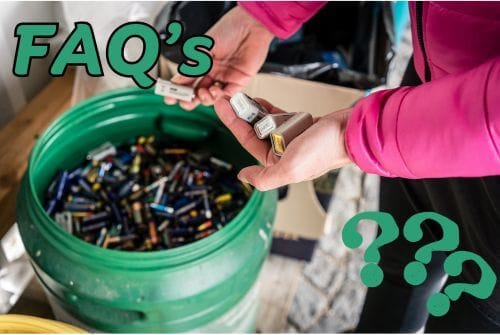
How do you properly dispose of batteries?
Tape the terminals and never put lithium-ion batteries in household garbage or recycling bins; alkaline and lantern batteries can be disposed of in the trash. Alternatively, many stores that sell batteries will take them back for recycling.
Can batteries be thrown in recycle bin?
It is illegal to throw rechargeable and most single-use batteries in your trash or recycling bin.
Household alkaline batteries can be tossed in the garbage, but it is dangerous and can lead to serious property damage, injury, or even death.
To properly dispose of waste batteries, they must be recycled or taken to a household hazardous waste collection point.
What batteries Cannot be recycled?
Single-use batteries containing lithium cannot be recycled, such as button-cell, coin, or lithium batteries, and should not be put in the trash or municipal recycling bins.
Can LFP battery be recycled?
Lithium iron phosphate batteries must be recycled in order to achieve a circular economy and prevent hazardous waste. Reusing these batteries sustainably will ensure their performance remains stable and impurities are kept at a minimum
How can I find a recycling location near me?
Use Earth911 and Call2Recycle to easily find a recycling location near you.
Thanks for stopping by our bee hive and reading up on recycling old batteries. Don't forget to check out our review article on LFP batteries!

Bertie
Before you leave, if you haven't already done so, please subscribe so you will be the first to see reviews you can rely on.










Member discussion